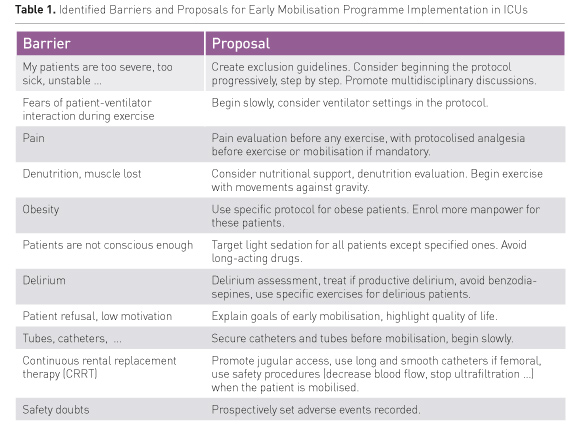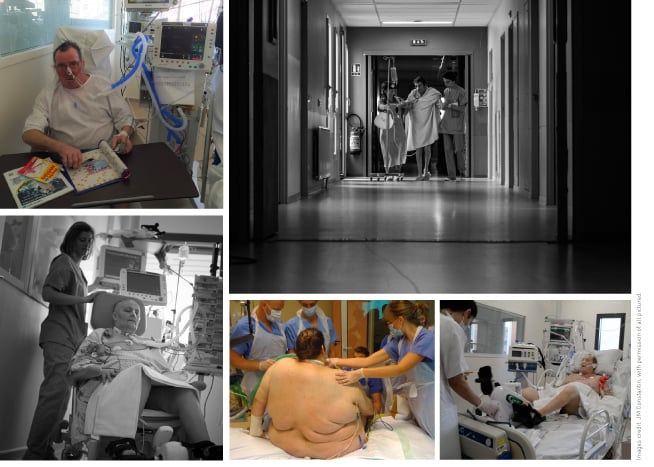ICU Management & Practice, Volume 16 - Issue 4, 2016
For years, 28-day survival was the holy grail of ICU physicians. As ICU survival continues to improve, a high proportion of these ICU survivors experience significant cognitive, psychological, and physically disabling side effects of their ICU stay. These consequences of critical illness, regardless of their admitting diagnosis, have a dramatic impact on quality of life. Nearly half of these individuals are unable to return to their previous work more than one year after hospital discharge (Pandharipande et al. 2013).
A change in ICU paradigm, sedation-ventilation-organs support, occurred in the last 15 years. Accumulating evidence suggests that the management of sedation can have an important effect on the outcomes of patients who are treated in ICUs. Nevertheless, a systematic review found that reduction of sedation levels decreased ICU length of stay and ICU-related complications, but failed to improve long term outcomes (Minhas et al. 2015). If avoiding deep sedation is not efficient, by itself, to improve long-term outcomes, it allows early mobilisation in the ICU setting; this is the first step. Early rehabilitation in ICU was initially a concept, but several studies were published to highlight the feasibility (Schweickert et al. 2009). The benefits of early mobilization include reduction in length of stay both in the ICU and hospital as well as improvements in strength and functional status. Such benefits can be accomplished with a remarkably acceptable patient safety profile.
All these studies include recommendations for implementing treatment programmes to improve ICU patients’ physical, cognitive and mental health impairments, with structured rehabilitative patient physical activity timed closer to ICU admission rather than ICU discharge. This point is crucial. ICU mobilisation should not be reserved for difficult to wean patients, or at the time of discharge. ICU mobilisation must be implemented in the early phase of ICU stay.
Even if feasibility, safety and efficacy have been confirmed by several studies, implementation of early mobilisation in ICU remains anecdotal in daily practice, all over the world (Hodgson et al. 2015). The real question is how to move on from the New York Times article about early mobilisation as a “tactic” (Kolata 2009) to making it an integral part of standard care in ICU, as with glycaemic control or basic nursing. In our experience, early mobilisation is an integral part of standard care because it has been protocolised. Implementing an early rehabilitation programme in the ICU is teamwork, that must be built according to published data and adapted to the local environment. This is the second step (Hickmann et al. 2016; Morris et al. 2008; Laurent et al. 2016).
Most times, implementing a protocol is not enough, and reported reasons for not mobilizing patients vary widely. They include mechanical ventilation, catecholamine infusion, impaired consciousness, poor functional status, safety considerations, limited staff capacities and so on. To identify local barriers encountered to early mobility is a major issue in this process, and this is the only way to move on. This is the third step (Dubb et al. 2016). Barriers and proposals from different hospitals are summarised in Table1. To summarise barriers and proposals, when we hear: “It is too difficult for us, it’s impossible in our ICU”, just consider early mobilization as a quality-of-care assessment tool in ICU. If everything is well done for our patients—light sedation, avoiding fluid overload, providing adequate nutritional support, perfect ventilator support—so early mobilisation will be like the cherry on top of a cake.

Providing early mobilisation with a high degree of supportive care requires experienced and coordinated multidisciplinary teams. Nurses in the ICU, especially when they are young professionals, may be frightened to mobilise patients. These fears are justified; this is a mandatory aspect to ensure patients’ security during early mobilization implementation. Formation of professionals involved in mobilisation process is the good answer to fears. Because nurses’ turnover in the ICU is sometimes really short, and because ICU staff teams are really large, it is important to identify and promote champions of education in the staff. These champions will be leaders of early mobilisation, and they will be able to carry out formation programmes for all the staff. Because the initial and continuing training are key points of success, the formation programme is the fourth step.

Team motivation is probably not an issue in the process of early mobilisation; team motivation is just the result of the process. Short-term effects of early mobilisation on delirium and patient feeling, as the hope of long-term quality of life improvement, are sufficient encouragement for ICU staff. But motivation could be in the first plan if fears, doubts and inadequate workload have been removed by a protocol including an algorithm for patient-centred care with an adequate educational programme, which is part of the early Comfort using Analgesia, minimal Sedatives and maximal Humane care or e-CASH concept (Vincent et al. 2016).
References:
Dubb R, Nydahl P, Hermes C et al. (2016) Barriers and strategies for early mobilization of patients in intensive care units. Ann Am Thorac Soc, 13(5): 724-30.
PubMed ↗
Hickmann CE, Castanares-Zapatero D, Bialais E et al. (2016) Teamwork enables high level of early mobilization in critically ill patients. Ann Intensive Care, 6(1): 1–11.
PubMed ↗
Hodgson C, Bellomo R, Berney S et al. (2015) Early mobilization and recovery in mechanically ventilated patients in the ICU: a bi-national, multi-centre, prospective cohort study. Crit Care, 19: 81.
PubMed ↗
Kolata G (2009) A tactic to cut I.C.U. trauma: get patients up. Jan 11. [Accessed: 21 October 2016] Available from nytimes.com/2009/01/12/health/12icu.html
Laurent H, Aubreton S, Richard R et al. (2016) Systematic review of early exercise in intensive care: a qualitative approach. Anaesth Crit Care Pain Med, 35(2): 133–49.
PubMed ↗
Minhas MA, Velasquez AG, Kaul A et al. (2015) Effect of protocolized sedation on clinical outcomes in mechanically ventilated intensive care unit patients: a systematic review and meta-analysis of randomized controlled trials. Mayo Clin Proc, 90(5): 613–23.
PubMed ↗
Morris PE, Goad A, Thompson C et al. (2008) Early intensive care unit mobility therapy in the treatment of acute respiratory failure. Crit Care Med, 36(8): 2238–43.
PubMed ↗
Pandharipande PP, Girard TD, Jackson JC et al. (2013) Long-term cognitive impairment after critical illness. N Engl J Med, 369(14): 1306–16.
PubMed ↗
Schweickert WD, Pohlman MC, Pohlman AS et al. (2009) Early physical and occupational therapy in mechanically ventilated, critically ill patients: a randomised controlled trial. Lancet, 373(9678): 1874–82.
PubMed ↗
Vincent JL, Shehabi Y, Walsh TS et al. (2016) Comfort and patient-centred care without excessive sedation: the eCASH concept. Intensive Care Med, 42(6): 962–71.
PubMed ↗







